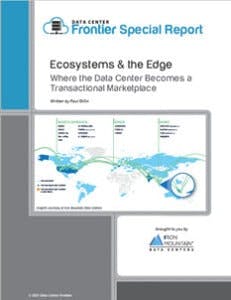Ecosystems at The Edge: Where the Data Center Becomes a Marketplace
When you look at the edge as a business hub, then you can see how small data centers can be transformed into full-fledged service providers and how the edge can fuel digital transformation. This launches our special report series on “Ecosystems & the Edge: Where the Data Center Becomes a Transactional Marketplace.”
Get the full report.
Rapidly evolving edge computing architectures are often seen as a way for businesses to enable new applications that require low latency and place computing close to the origin of data.
While those are important use cases, what is less often discussed is the opportunity for businesses to leverage the edge to spawn ecosystems that generate new revenue. To realize this value, companies must think of the edge as more than just a collection point for data from intelligent devices. They should broaden their vision to see the edge as a new business hub. These small data centers can evolve into full-fledged service providers that attract local businesses, generate e-commerce transactions and enable interconnections that never touch the central cloud.
Edge computing is an expansion of cloud infrastructure that moves data collection, processing and services closer to the point at which data is created or used.
Edge computing is an expansion of cloud infrastructure that moves data collection, processing and services closer to the point at which data is created or used. It is the fastest-growing segment of the cloud category with the total market expected to expand 37% annually through 2027, according to Grand View Research. The Linux Foundation estimates that the global power footprint for infrastructure edge deployment will grow from 1 GW in 2019 to over 40 GW by 2028.
Edge computing is also the subject of many misconceptions, however, led by the belief that its principal value is to manage intelligent devices like cameras and sensors. That is only one scenario; the potential to fuel digital transformation is much greater.
Data Center Frontier’s Editor in Chief Rich Miller and executives from Iron Mountain discuss Ecosystems and the Edge. Watch on demand today!
The bigger picture sees edge as an extension of cloud hubs and corporate data centers into regions and applications that can’t be served adequately by today’s cloud infrastructure. That opens up a host of new business opportunities.
A New Breed of Transaction
Distributed cloud infrastructure enables new types of transactions that are impractical today. Most of these center on partner ecosystems that develop around edge data centers. A few examples are:
- Streaming video services in the cloud can interconnect with content delivery networks near the edge for caching and last-mile delivery. Streaming video can be delivered that’s customized to the device level.
- E-retailers will tap into local networks of suppliers, order fulfillment companies, warehouses and delivery networks to enable just-in-time delivery and tracking.
- Healthcare insurers entering a new region will use interconnection to link up to local care providers, transportation networks, equipment providers and pharmacies to guarantee quality service delivery.
Package delivery services will enter new markets by interconnecting with regional logistics firms and transportation fleets. - Green energy providers will find contractors, local generation facilities and even drone operators to install, inspect and maintain equipment.
- Real-time ad brokers will customize messages to local languages and cultural preferences.
- Sensor-enabled predictive maintenance of equipment in the field will enable businesses to identify problems based on sensor readings and dispatch repair crews before equipment fails.
Redeploying compute power closer to the point of the transaction can cut response times by 90%.
Many of these ecosystems will be based on low- latency connections that edge facilities can deliver. Applications like augmented reality, remote vehicle control, real-time gaming and point-of-sale credit card fraud detection can’t tolerate 100-millisecond response times from a cloud server. Redeploying compute power closer to the point of the transaction can cut response times by 90%. In scenarios like autonomous vehicles that is the difference between life and death.
Download the full report, “Ecosystems & the Edge: Where the Data Center Becomes a Transactional Marketplace” courtesy of Iron Mountain to learn more about how the edge can help small data centers transform into full-fledged service providers and fuel digital transformation. In our next article, we’ll take a closer look at multi-tiered architecture, distributed intelligence and the global potential provided by the edge.





